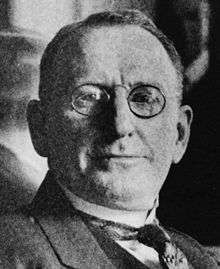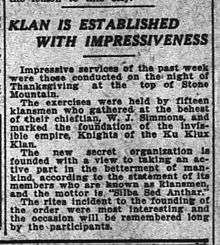William Joseph Simmons
William Joseph Simmons (May 6, 1880 – May 18, 1945) was an American fraternal organizer who founded and led the second Ku Klux Klan from Thanksgiving evening 1915 until being replaced in 1922 by Hiram Wesley Evans.[2]
William Joseph Simmons | |
|---|---|
 | |
| Imperial Wizard of the Knights of the Ku Klux Klan | |
| In office 1915–1922 | |
| Succeeded by | Hiram Wesley Evans |
| Personal details | |
| Born | May 6, 1880 Harpersville, Alabama |
| Died | May 18, 1945 (aged 65) Atlanta, Georgia |
| Political party | Democrat[1] |
Early life
Simmons was born in Harpersville, Alabama, to Calvin Henry Simmons, a physician, and his wife Lavonia Simmons née Davis, daughter of Thomas C. Davis.[3] In his younger years, he attempted to study medicine at Johns Hopkins University, but unable to afford it, opted to serve in the Spanish–American War instead. After receiving an honorable discharge, he became a teacher for the Methodist Episcopal Church, South but was suspended by the church in 1912 for inefficiency.
Simmons later joined two churches and twelve different fraternal organizations, which flourished in the early twentieth century. He was known as "Joe", "Doc" (in reference to his medical training) or "Colonel" (referring to his rank in the Woodmen of the World).[4]
Ku Klux Klan

While recovering in 1915 after being hit by a car, Simmons decided to rebuild the Klan which he had seen depicted in the newly released film The Birth of a Nation directed by D. W. Griffith. He obtained a copy of the Reconstruction Klan's "Prescript", and used it to write his own prospectus for a reincarnation of the organization. Simmons' planning took place during a period which coincided with the lynching of Leo Frank, on August 16, 1915. Frank, a northern Jew who worked as a manager at a pencil factory, had been sentenced to death for murdering a young female factory worker.
As the nucleus of his revived Klan, Simmons organized a group of friends, in addition to two elderly men who had been members of the original Klan. On Thanksgiving night 1915, they climbed Stone Mountain to burn a cross and inaugurate the new Klan, with fifteen charter members.[4] Simmons' later account of the founding included a dramatic story of "a temperature far below freezing", although weather records showed that the temperature had never fallen below 45 °F (7 °C) that night on Stone Mountain. Simmons declared himself the Imperial Wizard of the Invisible Empire of the Knights of the Ku Klux Klan.
The imagery of the burning cross, which had not been used by the original Klan, had been introduced by Griffith in Birth of a Nation. The film, in turn, had derived the image from the works of Thomas Dixon, Jr., upon which the film was based. He had been inspired by the historical practices of Scottish clans, who had burned crosses as a method of signaling from one hilltop to the next. The image also occurs in Lady of the Lake (1810), a long poem by Walter Scott.[5] The signature white robes of this new Klan also likely come from Dixon via Birth of a Nation.[6]
In the first years of the new Klan, a few thousand members enrolled, although many more later pledged allegiance, particularly in industrial cities of the Midwest. Initially portraying itself as another fraternal organization, the Klan was opposed to the new immigrants from southern and eastern Europe—who were mostly Jews and Roman Catholics—and anybody else who was not a native-born Anglo-Saxon or Celtic Protestant.[4]
Later life and death
When the New York World exposed violent affairs conducted by the Ku Klux Klan, Simmons was called to testify in front of the U.S. House Committee on Rules. Hearings began in October 1921 and lasted for over a week. Simmons distanced himself from violent events and stressed the Klan's fraternal nature. Congressional hearings ended with no direct consequences for the Klan, though Simmons lost his influence.
Having increased his own network of influence, Hiram Wesley Evans succeeded Simmons in the position of the Imperial Wizard in November 1922. Simmons was at the same time elected Emperor for life.[7] The Klan started to decline after a peak of membership and influence in 1925, particularly because of the scandal in which D.C. Stephenson, one of its top leaders, was convicted of killing Madge Oberholtzer.
Simmons died in Atlanta on May 18, 1945.
Publications
- The Ku Klux Klan (1917)
- ABC of the Invisible Empire, Knights of the Ku Klux Klan (1920)
- The Klan Unmasked Atlanta, Ga., Wm. E. Thompson Pub. Co. 1923
- America's menace; Or, The Enemy Within (An Epitome) (1926)
- The Ku Klux Klan: Yesterday, Today and Forever (1930s)
References
- https://www.britannica.com/topic/Ku-Klux-Klan#ref136543
- "The 20th Century Ku Klux Klan in Alabama". Alabama Department of Archives and History.
- Alabama Confederate Pension request dated 6 Dec 1920, completed by Lavonia Davis
- "The Various Shady Lives of the Ku Klux Klan". Time. April 9, 1965.
An itinerant Methodist preacher named William Joseph Simmons started up the Klan again in Atlanta in 1915. Simmons, an ascetic-looking man, was a fetishist on fraternal organizations. He was already a "colonel" in the Woodmen of the World, but he decided to build an organization all his own. He was an effective speaker, with an affinity for alliteration; he had preached on "Women, Weddings and Wives," "Red Heads, Dead Heads and No Heads," and the "Kinship of Kourtship and Kissing." On Thanksgiving Eve 1915, Simmons took 15 friends to the top of Stone Mountain, near Atlanta, built an altar on which he placed an American flag, a Bible and an unsheathed sword, set fire to a crude wooden cross, muttered a few incantations about a "practical fraternity among men," and declared himself Imperial Wizard of the Invisible Empire of the Knights of the Ku Klux Klan.
- Lehr, Dick. Birth of a Nation: How a Legendary Filmmaker and a Crusading Editor Reignited America's Civil War. Public Affairs Press, 2014.
- "A 1905 Silent Movie Revolutionizes American Film—and Radicalizes American Nationalists". Southern Hollows podcast. Retrieved 3 June 2018.
- "Klan Makes Simmons Emperor For Life; Dr. H.W. Evans of Dallas Is the New Imperial Wizard--Clarke Imperial Giant". The New York Times. November 29, 1922.
| Preceded by Nathan Bedford Forrest (1869; as Grand Wizard) |
Imperial Wizard of the Ku Klux Klan 1915–1922 |
Succeeded by Hiram Wesley Evans |